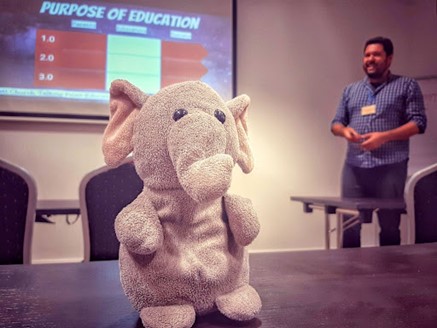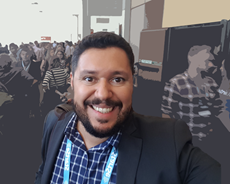To PBL or not to PBL: Four Success Stories that Might Help you Decide
To PBL or not to PBL: Four Success Stories that Might Help you Decide
by André Hedlund
As a teacher, I have always sought to innovate in the classroom and implement approaches that give more voice and agency to students. I have worked in both highly rigid contexts, where I could not steer away from the predetermined curriculum for even a second, and in very flexible scenarios, where I didn't even need to follow the coursebook closely. What I learned from these experiences is that, in most cases, what schools offer is disconnected from the reality and everyday life of our students. However, in 2016, I had an experience that would change my life. I went on an exchange program and spent a month in the United States, where I had my first contact with the concept and practice of Project-Based Learning - PBL.
PBL will sound familiar to many readers. It is a term that has cropped up in the names of books, events, webinars, and round tables. However, how does it actually work? What I saw during my short exchange program in the state of Wyoming was a lot of collaboration, engagement, enthusiasm, and fun, besides the incredible projects themselves.
My first PBL idea and experience was as simple as one could think. It all came down to a very cute and gray stuffed animal. His name is Mr. Trunk and you can find out more about him on social media (#mrtrunktravels). My students took him home and on trips, introduced him to their friends and families, and took pictures or recorded videos of him so that we could use his portfolio to learn the target language we were working on. That little project ended up sending Mr. Trunk to more than 20 countries!

(Mr Trunk at a conference in Bratislava, Slovakia. Photograph credit: Christopher Walker, 2019)
But there’s more. I share here four other stories that demonstrate my growing love for PBL. Each story addresses a different level and very unique realities. I must however highlight four challenges that prevented me from successfully implementing PBL immediately. These are the perceptions I gained the hard way in the first attempt and should not be overlooked if success is what you seek:
- Real PBL means long-term commitment and a curriculum stemming from the big project.
- PBL is about the students. The project will arise from them, and only then can they call it THEIR project.
- It takes time to change your students' mindset, so we might start by working on small-scale projects instead of the real PBL. In other words, we must be clear on the difference between doing the occasional project in class, and the ideas that are central to PBL itself.
- Focus more on the process and not so much on the final product. PBL is more about the journey than the final destination.
PBL has the potential to impact not only the lives of those involved, but also their community. The central purpose of this method is to offer solutions to important problems or challenges through investigation, using the curriculum as a foundation. Ideally, we should use the process as a springboard for learning and help students create a final product that can be presented. PBL works as a learning catalyst.
Shattering Prejudice: My friend from Iraq
Sadly, many of the opinions people hold about the Middle East, especially Iran and Iraq, are extremely stereotyped and negative. We are bombarded with terrible news, which might explain our prejudice. In 2017, an Iraqi woman asked to join my Facebook group to practice English. At first, unfortunately, I treated her with suspicion and avoided adding her because of all these horrible things we see on TV. But then I said to myself: you know what? I'm going to talk to her.
I found out that she went to the University of Education in her city to study English and become a teacher. She became my friend and we have been talking ever since. Her name is Afrah; she loves fish and pizza. She has two beautiful nieces, Zahraa and Mariam, who dressed up as Santa Claus for Christmas in 2016, and her father is the kindest man she knows. He offers help to oppressed families who are persecuted by Islamic State in Mosul. In short: she is a person, a human being, like any other.
This story leads me to Katherine Bilsborough (2013):
“Projects bring real-life into the classroom; instead of learning about how plants grow (and all the language that goes with it), you actually grow the plant and see for yourself. It brings facts to life.”
The completely casual virtual meeting with my new Iraqi friend brought life to the classroom and ignited my students' desire to learn more about other peoples and cultures. Our project was simple: to learn more about Iraqi culture and Afrah's life. She was interviewed by my students on several occasions. At one point, while we were studying parts of the house, she sent pictures of her home and made a video call to show her garden. It was a great example of bringing the real world into the classroom, and made the learning all the more tangible.
This is the Voice
The second experience involved me helping to design and deliver an English immersion course. After the coordinators chose the coursebook, I was called in to make the course less book-bound and more up-to-date, even though I still had to follow all the pages of the material. We had classes with students of different ages, but all were adults. The teachers I hired and worked with across four groups for 8 hours a day structured our classes according to three main pillars: content, games, and the project.
Early in the course, we decided to take all the groups, ranging from basic to advanced, to a larger room to explain how the project would be carried out. We talked about the importance of frequent meetings, exchanging information, and the creation of a final product to present to classmates.
At the end of the course, we were delighted to see what the students had produced. The A1 group had created a Facebook page about health in old age. The A2 group had developed a website for a travel agency with photos of their latest destinations. The B1 group had produced a recital and a cultural exhibition featuring a violin concert. The C1 group had created a variety magazine focused on technology and sustainability. After watching each of the presentations and giving feedback, we did our version of ‘The Voice’ and discovered how talented some of the students were.
Goiás Without Borders
At the end of 2017, we learned that the local government was seeking partners to create a curriculum and teach the 300 young people from public schools who had been awarded scholarships through the ‘Goiás Without Borders’ program. These young people were leaving Brazil for the USA in less than a month, and we needed to develop their language and leadership skills over the course of a week’s worth of eight-hour study days.
We did not have any teaching materials or a pre-established curriculum. I designed the entire curriculum and recorded video training tutorials for the team. I also taught some classes. I created independent modules focused on the competences that the government program intended to develop: leadership, entrepreneurship, oral communication and effective communication, collaboration, and networking.
At the end of that intense week, the students prepared slide presentations, plays, dance numbers, and musical performances on the subjects they had chosen as their project. The result? It was a huge success. We received positive feedback from the over 170 students who completed the post-course satisfaction survey, and we followed their trip closely to New Jersey.
The Brazil-Mexico Connection
When I worked as a bilingual mentor, we offered a course that partnered with the ACT tests. Our team decided to bring together two schools studying the same program, one in Brazil and the other in Mexico. I did some brainstorming sessions with my colleagues and designed a project-based learning guide based on one of the ACT prep modules. After several meetings with our partner program provider in Mexico, we launched the project, trained the teachers involved, and introduced the high school students to each other.
The students needed to contact their international partners and create a project based on the work of a non-governmental organization (NGO) that focused on preselected pillars (education, culture, and sustainability). The result was incredible despite - or perhaps even because of - the bumps along the way. The students had to report on their experience working together; their report highlighted what we could all do to improve things, which is precisely what happens in the real world.
Conclusion
Working with PBL is certainly challenging. However, in my experience, the reward was much greater than I expected. I saw with my own eyes how my students were excited about the possibility of working on something they had chosen, where their skills were explored and their creativity put to the test.
I don't know if you noticed, but I didn't always work with “the real PBL”. Sometimes, I had to work on projects alongside the coursebook and couldn't include those projects in the final assessment. But this shouldn't be an obstacle to incorporating elements of PBL in our lessons. While we may not always be able to do PBL as it was idealized – the curriculum stemming from the project - we can definitely work with relevant and long-lasting projects that lead us closer to the real PBL.
I believe in the English language as an empowering tool, something that allows our students to reflect more deeply and transform their daily lives. I know that not everything is PBL. I know the importance of explicit instruction and practice in the classroom, whether that happens to be real or virtual. I'm not saying we should completely discard what we've been doing. In fact, at the most basic levels and while structuring new knowledge, it's very important to have more repetition and targeted practice. At times, we need lessons that are more teacher-centered. Nevertheless, I hope my stories have convinced you to give some form of PBL a chance.
References
Bilsborough, K. (2013). TBL and PBL: Two Learner-Centred Approaches. Accessed at: https://www.teachingenglish.org.uk/article/tbl-pbl-two-learner-centred-approaches.
Biography
 André Hedlund is a Chevening Alumnus - MSc in Psychology of Education from the University of Bristol, an Educational Consultant, Speaker, university Lecturer on Bilingualism and Cognition, and Academic Director of EdYOUFest. Also a member of BRAZ-TESOL’s Mind, Brain, and Education SIG. He's the author of The Owl Factor: Reframing your Teaching Philosophy, and he blogs at edcrocks.com.
André Hedlund is a Chevening Alumnus - MSc in Psychology of Education from the University of Bristol, an Educational Consultant, Speaker, university Lecturer on Bilingualism and Cognition, and Academic Director of EdYOUFest. Also a member of BRAZ-TESOL’s Mind, Brain, and Education SIG. He's the author of The Owl Factor: Reframing your Teaching Philosophy, and he blogs at edcrocks.com.